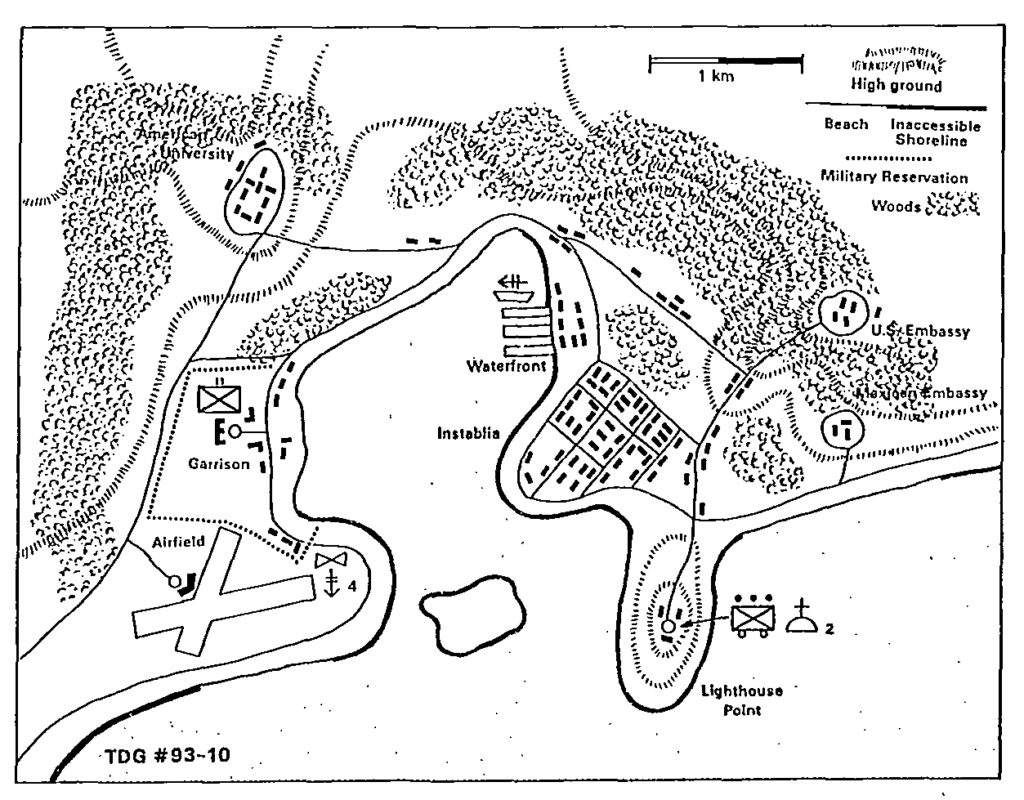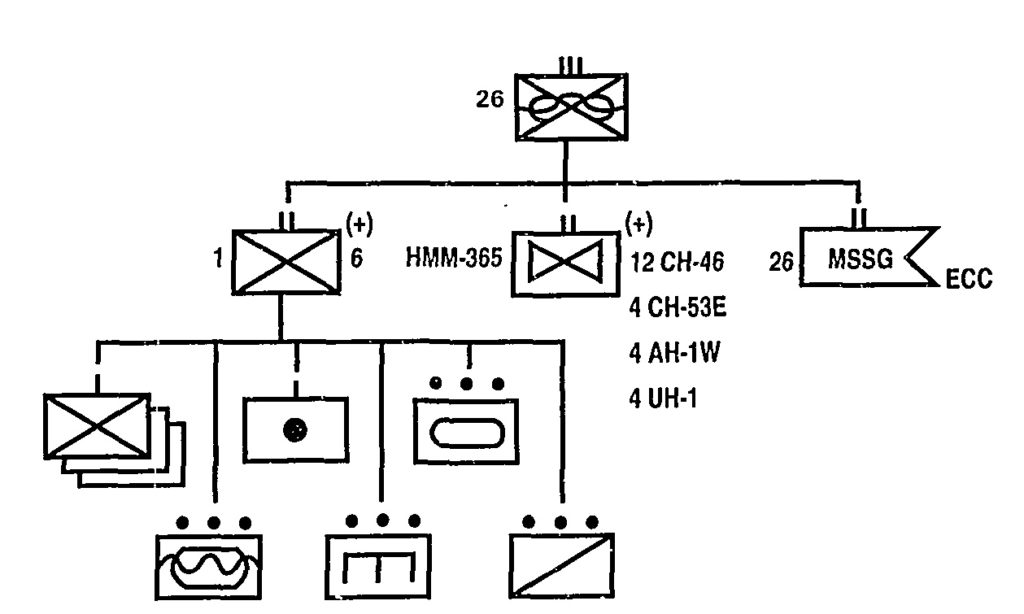NEO From Instablia
Posted on May 15,2019Article Date Oct 01, 1993
by Maj John F. Schmitt, USMCR
Situation
 You are the operations officer of 26th Marine Expeditionary Unit, or 26th MEU(SOC), organized as follows:
You are the operations officer of 26th Marine Expeditionary Unit, or 26th MEU(SOC), organized as follows:
* A command element (CE).
* The ground combat element (GCE) consists of 1st Battalion, 6th Marines reinforced with an M198 artillery battery, a tank platoon, an assault amphibian platoon with 10 AAVP7s (enough to carry one reinforced rifle company), a reconnaissance platoon, and a combat engineer detachment.
* The aviation combat element (ACE) consists of HMM-365 reinforced, deploying with 4 CH-53ES, 12 CH-46s, 4 AH-1W Cobras, and 4 UH-1N Hueys.
* The MEU Service Support Group (MSSG-26).
The MEU is afloat on a routine deployment. Suddenly, in the nearby Third World country of Instablia a disaffected military faction launches a violent coup attempt. The Inslablian President escapes capture but is believed to be in hiding in the countryside near Instablia City. Random violence and looting break out in the streets. AntiU.S. sentiment grows. A Canadian attempt to evacuate by air fails when Inslablian military forces intern the aircraft and halt the evacuees en route to the airport; Instablian forces open fire; the Canadians flee to the American University, suffering half a dozen casualties. The U.S. Ambassador, his staff, and numerous Americans and foreign nationals are for all intents and purposes besieged in the U.S. and Mexican Embassies. A handful of Marine security guards plus contract security forces of questionable utility protect the personnel at the U.S. Embassy; there are no security personnel at the university; and the security situation at the Mexican Embassy is unclear. To this point there have been no actual military or mob actions directed at the embassies or the university, but the situation is described as “increasingly volatile.”
Those Instablian military forces that have not openly declared support for the coup are of questionable reliability and loyalty. These elements consist of an infantry battalion at the lnstablia garrison, four Hip-C attack/transport helicopters at the military annex of the airport, a platoon of motorized infantry with two S-60 antiaircraft guns at Lighthouse Point, and six gunboats (with .50 caliber machineguns) operating from the waterfront.
The U.S. Ambassador has asked the State Department to arrange for the prompt evacuation of 101 persons from the U.S. Embassy, 68 from the Mexican Embassy (including 18 Americans), and 150 from the American University campus. Rules of engagement state that U.S. forces may fire only when fired upon. The situation has not yet reached critical mass, but the Ambassador estimates that evacuation will be necessary within the next 24 hours. Your amphibious ready group (ARG) is currently about 1,000 nautical miles from the objective area. The commanding officer instructs you to develop an evacuation plan based on the following assumptions:
* Given the volatility of the current situation and the MEU’s location, the initial launch of forces may have to take place from as far as 400 nautical miles from lnstablia City.
* Due to this range only the CH-53s will be available for the first phase of the evacuation and that one or more aerial refuelings may be required en route.
* Because the ARG will continue to steam toward the objective area, the CH-46s will be available for employment within 18 hours (at the most) of the launch of the first wave of CH-53s.
* The MEU can be in position to commit surfaceborne forces by AAV or landing craft, if needed, within 24 hours of the initial launch.
* The environment will likely be in the words of the ambassador, “extremely nonpermissive. At the first sign of military force expect all hell to break loose.”
* Instablian military forces will likely attempt to interfere with the evacuation and at some point it may become necessary to engage Instablian forces in combat in order to conduct the evacuation.
* Four AV-8B Harriers and two KC-130 refuelers assigned to the MEU will be available by fly-in deployment (from a nearby friendly country) to support all phases of the operation.
For planning purposes, your CH53s can carry 30 passengers each; your CH-46S. 15; and your AAVs, 25. The U.S. Embassy has landing zone space for three CH-53s or six CH-46s and the Mexican Embassy space for one CH-53 or two CH-46s. There is unlimited space for helicopters at the University. The size of your helicopter waves is not limited by ship deck space.
Requirement
 Develop your evacuation plan. It is not necessary to write a complete operations order, but describe your concept of operations, tasks or phases, contingency plans, and coordinating instructions. Provide a sketch of your plan and a brief explanation. Send your solution to Marine Corps Gazette, TDG 93-10, P. O. Box 1775, Quantico. VA 22134.
Develop your evacuation plan. It is not necessary to write a complete operations order, but describe your concept of operations, tasks or phases, contingency plans, and coordinating instructions. Provide a sketch of your plan and a brief explanation. Send your solution to Marine Corps Gazette, TDG 93-10, P. O. Box 1775, Quantico. VA 22134.




